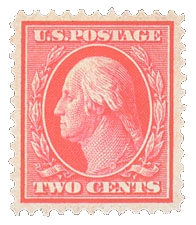

Washington Head
Denomination in Letters
Perf 11
Watermark Check: this stamp must be checked for watermark.
| Watermark | Press | Number |
| double-line | flat plate | 519 (see caution below) |
The existence of this stamp is something of a fluke. According to Johl, it started in 1910 when the St. Louis postmaster transferred a large quantity of imperforate sheets of the imperforate 1908 two cent stamp, Number 344, to the United States Automatic Vending Company of New York. Somehow the sheets came into the possession of the postmaster of New York City and in 1917 he asked the Bureau if he could return them for credit, to which the Bureau agreed. As a cost saving measure, the Bureau decided to add perforations to the sheets rather than simply destroy them. By 1917 the perforation had been changed to 11, the 12 gauge perforation had not been used since 1914, and a new variety was inadvertently created. It is interesting to note that if the stamps had been returned in 1916 and reperforated then, this variety would be perf 10 and not perf 11.
Although more than half a million of these stamps were issued, most were used for postage. The two cent stamp was a common stamp of the era and the perf 11 and 12 stamps were hard to distinguish without close inspection. Most of these stamps are lost forever, since collectors were unaware of their existence at the time, and most of them were simply discarded as common. Ironically, had the stamps been perforated in 1916 with gauge10 perforations, the difference would have been more noticeable, and many more would most likely have been saved.
Caution
This stamp can be faked by perforating the imperforate Number 344 on all four sides. In fact, as mentioned above, the stamp was actually perforated by the USPS using left over stock from the imperforate sheets of Number 344, as an economy measure during World War I. It would be advisable to have the perforations looked at very closely before assuming this stamp is the scarce 519. Fakes made from the single-line watermarked imperforate, Number 384 are much easier to weed out, since the real 519 must be on double-line watermarked paper. Additionally, the color is usually a dull carmine, not a bright or rosy red.





